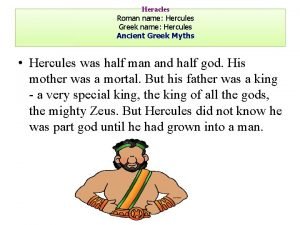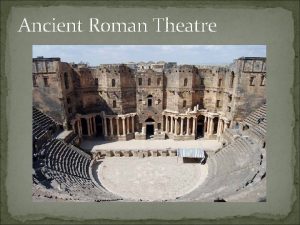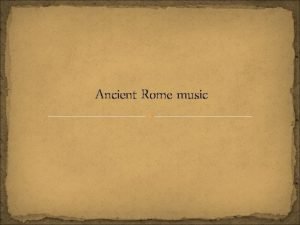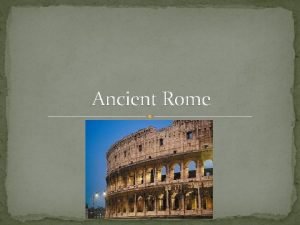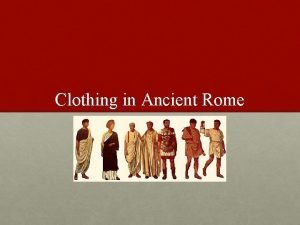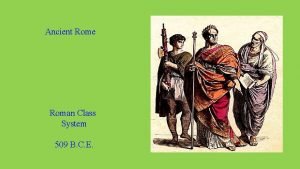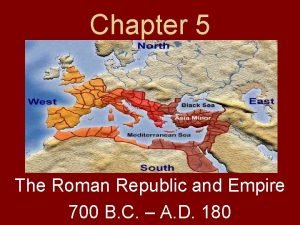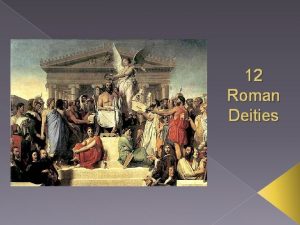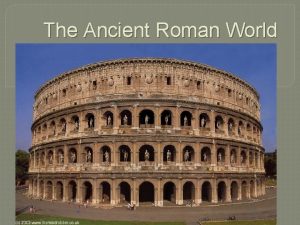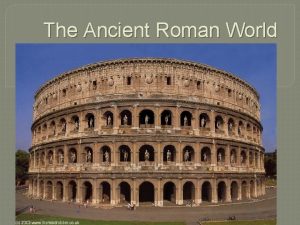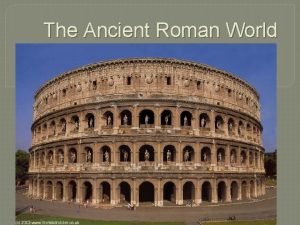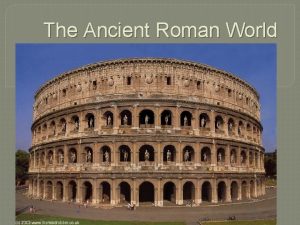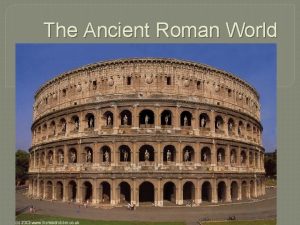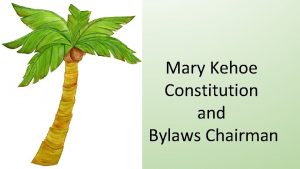The Constitution Origins Ancient Greek and Roman origins































- Slides: 31

The Constitution

Origins ¡Ancient Greek and Roman origins ¡representative democracy ¡balanced and limited government ¡John Locke and natural rights (ex. life, liberty, and the protection of property) ¡Montesquieu and separation of powers each branch of government should have different roles

Why have a written constitution? ¡Americans felt that the British had wronged them, and wanted to make sure that the certain rights could not be changed or even taken away from them. ¡A written constitution was a way to outline all of the principles of government and the rights of the people, which could last for generations.

Preamble ¡We the People of the United States, in Order to form a more perfect Union, establish Justice, insure domestic Tranquility, provide for the common defense, promote the general Welfare, and secure the Blessings of Liberty to ourselves and our Posterity, do ordain and establish this Constitution for the United States of America.

Organization ¡The Constitution is composed of seven parts, which are called articles. They are: ¡The Legislature (Congress) ¡The Executive (President) ¡The Judiciary (Court System, Supreme Court) ¡Relations Among States ¡Amending the Constitution ¡Supremacy of National Government ¡Ratification

Article I: The Legislature ¡TWO houses of government ¡Bicameral 2 houses ¡Unicameral 1 house ¡The Senate and The House of Representatives ¡Why are there two houses?

Total Members in Congress: 535 (or 541) House of Representatives: 435 Senate: 100

Impact of Census Data

What are the requirements to be a U. S. Senator or Representative?

Representative Requirements ¡At least one Representative from each state; determined by population ¡Elected every two years ¡Must be at least 25 years old ¡Must have been a U. S. citizen for at least seven years ¡Must live in the state you represent

Senator Requirements ¡ 2 Senators from each state ¡ 1/3 of the Senators are elected every other year (6 year terms) ¡Why would they do this? ¡Must be at least 30 years old ¡Must have been a U. S. citizen for at least nine years ¡Must live in the state you represent

Vice President and Officers ¡The members of the Senate and the House of Representatives elect their own officers. ¡The Vice President of the United States is the President of the Senate. ¡The leader of the House of Representatives is the Speaker of the House.

Powers of Congress According to Section 8, Congress has the power to: ¡collect taxes ¡spend for the general welfare ¡borrow money ¡regulate commerce among the states and between countries ¡regulate immigration ¡coin money ¡regulate mail ¡regulate patents and copyrights ¡declare war ¡raise and support military forces ¡establish federal courts ¡“necessary and proper clause”

Necessary and Proper Clause ¡“To make all Laws which shall be necessary and proper for carrying into Execution the foregoing Powers. ” ¡Also called the “elastic clause” ¡Gives Congress the power to make laws about topics that were not an issue when the constitution was written ¡Can you think of examples of this?

Powers Denied to Congress Section 9 states that Congress cannot: ¡suspend the Writ of Habeas Corpus ¡requires government to bring a prisoner to court and explain why they are being held ¡pass ex post facto laws ¡can not punish someone for a law that was passed after they did something ¡favor one state over another ¡grant titles of nobility ¡no one can be a King, Queen, etc.

Powers Denied to the States ¡The state governments can not pass any laws that are inconsistent with federal laws ¡example: marriage equality ¡States are not allowed to: ¡coin money ¡make treaties or alliances ¡tax other states ¡keep troops or engage in war

The Executive Branch ¡The President

Presidential Requirements ¡Must be born in the United States ¡Must be at least 35 years old ¡Must have lived in the United States for 14 years ¡ 22 nd Amendment: 2 -term limit ¡ 25 th Amendment: If the President dies while in office, the Vice President takes over

Electoral College ¡We do not directly elect the President. ¡Instead, voters select their choice for president on the ballot. Whichever candidate wins the majority vote in that state gains all of the electors for that state. ¡This approach is called Winner Take All.

2016 Presidential Election Results What might be the benefits of a Winner Take All system?

Powers of the President ¡Some of the power of the President include: ¡nominate judges to the Supreme Court ¡pardon criminals who have broken the law ¡makes treaties with other countries ¡Commander in Chief of the Armed Forces ¡can create a Cabinet of advisors ¡can veto legislation passed by the Senate and the House of Representatives

Limits to the Executive ¡Veto can be overridden if 2/3 rd of the Senate and the House of Representatives agree ¡Congress can impeach the president due to misconduct, and remove him or her from office ¡The House of Representatives can impeach, and the Senate holds a trial on the accusations No President has been impeached AND removed from office.

The Judiciary ¡Supreme Court

Supreme Court Justice ¡ 9 justices ¡ one Chief Justice of the United States ¡ eight associate justices ¡Appointed by the President ¡Appointed for life; no term limits ¡No age requirements

Powers of the Supreme Court ¡Highest Federal Court ¡Hears cases arise from the Constitution, federal laws, or treaties ¡Hears cases of appeal from all state courts or lower courts as needed ¡Judicial Review: power to determine if a law is constitutional or not

Limits to the Judiciary ¡Justices can only decide the cases that come before them and cannot act on their own ¡Justices can be removed from office or impeached for bad behavior. ¡Congress can pass an amendment to overturn a Supreme Court Decision.

Article IV: The States ¡full faith and credit ¡requires each state to recognize the laws and court decisions of every other state ¡privileges and immunities ¡states cannot discriminate against citizens from other states ¡Congress can admit new states to the Union

Article V: How to Pass an Amendment ¡Step 1: Amendments must be proposed by 2/3 rds of both houses. ¡Step 2: Amendment must be approved by 3/4 ths of states. ¡Only 27 amendments have been proposed and approved.

Article VI: Supremacy of National Government ¡All debts from before the Constitution are still valid ¡The Constitution, all U. S. laws, and U. S. Treaties are to be the “Supreme Law of the Land” ¡No state or local law can go above national laws and treaties. Layer Cake Analogy: Frosting (on the top): Constitution Top Layer: Federal/National Gov’t Middle Layer: State Gov’t. Bottom Layer: Local Gov’t

Article VII: Ratification ¡ 9 of the 13 states needed to ratify, or pass, the Constitution

Image Credits ¡ Slide 7: https: //upload. wikimedia. org/wikipedia/commons/thumb/c/cf/Electoral_map_20122020. svg/600 px-Electoral_map_2012 -2020. svg. png ¡ Slide 8: https: //upload. wikimedia. org/wikipedia/commons/thumb/a/a 4/2010_census_reapportionment. s vg/600 px-2010_census_reapportionment. svg. png ¡ Slide 9: http: //www. brecorder. com/wp-content/uploads/2017/03/us-senate-1024 -1. jpg ¡ Slide 17: http: //thecollaboratory. wdfiles. com/local--files/american-government-2013/unitedstates-president-symbol-logo. jpg ¡ Slide 20: https: //upload. wikimedia. org/wikipedia/commons/thumb/3/3 f/United_States_presidential_electi on_results_by_county%2 C_2016. svg/1280 px. United_States_presidential_election_results_by_county%2 C_2016. svg. png ¡ Slide 22: ¡ Andrew Johnson: https: //upload. wikimedia. org/wikipedia/commons/c/ce/President_Andrew_Johnson. jpg ¡ Bill Clinton: http: //www. historyplace. com/specials/calendar/docs-pix/clinton. jpg ¡ Richard Nixon: https: //upload. wikimedia. org/wikipedia/commons/e/ee/Richard_Nixon, _official_bw_photo, _head_and_shoulde rs. jpg
 Texas constitution vs us constitution
Texas constitution vs us constitution Nc constitution vs us constitution
Nc constitution vs us constitution Constitution what is constitution
Constitution what is constitution Lesson 1 principles of the constitution
Lesson 1 principles of the constitution Ancient rome and the origins of christianity
Ancient rome and the origins of christianity Halloween has its origins in which ancient celtic festival
Halloween has its origins in which ancient celtic festival Greek amphitheatre
Greek amphitheatre Greek theater history
Greek theater history Cursus honorum
Cursus honorum Greek and roman geography
Greek and roman geography Greek and roman art similarities
Greek and roman art similarities Difference between roman and greek theatre
Difference between roman and greek theatre Hercules greek and roman name
Hercules greek and roman name Eros symbols and meanings
Eros symbols and meanings Zeus roman name
Zeus roman name The king of the greek gods
The king of the greek gods Means of communication in ancient times
Means of communication in ancient times Ancient india vs ancient china
Ancient india vs ancient china American victorian flower arrangements
American victorian flower arrangements Poor roman food
Poor roman food The history of clowns
The history of clowns History of theatre ancient rome
History of theatre ancient rome Roman houses
Roman houses Ancient roman toothbrush
Ancient roman toothbrush Ancient rome dance
Ancient rome dance Famous landmarks in rome
Famous landmarks in rome Ancient roman deities most resembled
Ancient roman deities most resembled Byzantine social pyramid
Byzantine social pyramid Clothing in ancient rome
Clothing in ancient rome Ancient roman class system
Ancient roman class system Roman transportation
Roman transportation Roman republic vs roman empire
Roman republic vs roman empire












